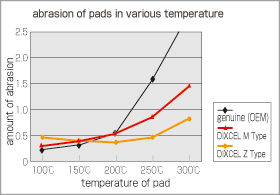Technical Articles
Brake Literature
About brake pad wear
 A common thinking is that ‘performance pads have faster wear rate compared to OEM pads’.
A common thinking is that ‘performance pads have faster wear rate compared to OEM pads’.
This is neither false or true, since the wear rate can vary. This is because pad wear rate is different depending on the temperature of the brake pads. The graph on the right shows the wear differences of the OEM brake pads to our performance pads; the M and Z type pads. The values are the measurement of pad wear after 0.4G braking from 80km/h, which was repeated 1000 times for each type of pad and each temperature. By looking at the graph, it is easy to see how the pad wear rate increases significantly as the pad temperature rises. OEM pads have a low wear rate when pad temperature is below 150℃, but have a much higher wear rate when the pad temperatures are above 300℃. When pad temperatures reach above 300℃, brake fade occurs for the OEM pads, and become almost useless in terms of braking power. Performance pads are designed for use on race circuits and for street performance, so they are developed to have optimal pad wear rate at temperatures around 250℃~600℃. At lower temperatures, the performance pads will have higher wear rate at lower temperatures when compared to the wear rate of OEM pads at low temperatures. If you are going to use your brake pads for ordinary street use, the statement ‘performance pads have faster wear rate compared to OEM pads’ will be true. Performance pads are for users who need pads for use on race circuit and for street performance, that last longer, safer, and superior performance compared to the OEM pads.

